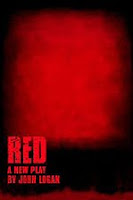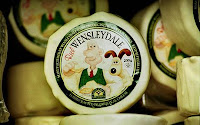
Let me preface this review by this: over the course of 13 years, I completed a double major in English Literature and Art History. Further, many phrases in this review are actually lines and paraphrases from the play, and are not always referenced by quotation marks. The play's subject matter appealed to both my majors on a deeply personal level, having invested so much time and effort on both, but it also raises interesting questions about the meaning of art in the world today. When we buy art, are we looking for something that goes with the decor of an existing room - something "so" big and with a particular colour scheme, are we merely looking for something 'pretty' to put on the wall, or are we looking for something to make us as viewers
think, and/or
feel, or challenge us. These are the types of questions the character of Rothko asks in John Logan's play
Red and are just some of the things the audience member might want to take away with them after the performance is over. I did - and more.
I felt this play was a homage (yes, I do pronounce the letter 'H') to art and artists. Logan uses vivid descriptions of paintings such as Matisse's The Red Studio and Caravaggio's Conversion of Saul and uses language so meaningfully - saying that to combat the dark corner of Santa Maria del Popolo, Caravaggio countered the challenge by making his commissioned work "luminescent from within" - words that so easily could be sniffed at and are given life through the vehicle of the actor, and, in this production, direction by Kim Collier.
It's about the creative process, as just that: a process that may or may not include reading Nietzsche's Birth of Tragedy (a book I coincidentally am currently reading), Schopenhauer, mythology, literature such as Shakespeare, and listening to music. "Tragedy is not to have balance in the fulcrum between Apollo and Dionysus" - I am paraphrasing a line from the play, but this is a reference to the aforementioned Nietzsche book and is a major discussion point between Rothko and his assistant Ken in the play.
The necessity of separating the art from the man. "Admire them but don't think you understand them", the character of Rothko advises Ken on the subject of Pollock, Picasso, Matisse, van Gogh - the greats of modern art movements. Ken may have thought he had an insight into these men because he is a painter himself, but Rothko has to teach him that all he can be is a viewer of art. The only art he can truly understand is of his own creation. It is always tempting to extrapolate the autobiographical in art and literature, irrespective of how much or how little one knows about the creator and in both disciplines (art and literature), that is officially discouraged...and yet, you have to paint/write of what you know. Therein lies authenticity, and conflict, and personal challenges/demons - was Dickens haunted by poverty because his own father went into the poorhouse, and is this why it figures so heavily in his books - or was he writing what he knew?
Abstract Expressionism vs Pop Art: Ken calls it "the last gasp of a dying race" and Rothko is still painting Abstract Expressionism in a time when Lichtenstein, Stella, Warhol, Hamilton (whom I adore), Johns, Rauschenberg, were making their marks upon the art world. Rothko stands a bit of a dinosaur, and Ken reminds him of the pride Rothko exhibited when he said that he, Pollock, de Kooning, and others, stomped on Cubism and obliterated its relevance. When the same is done to him, Rothko hopes they have the generosity to be more kind about it than he and his compatriots were.
Not surprisingly, after two years of working with Rothko in the studio, the employee becomes the one who asks the questions Rothko asked of him in the beginning: What do you see? How do you feel? The answers aren't good - they paint the picture of a man in inner conflict, but with the strength and conviction to ask for his paintings back, and this leads me to another discussion point: one that revolves around a certain distaste for art/artists as commodity.
"When did I become a noun?", Rothko asks. When indeed. He has an equal distaste for pretension and monkey chatter such as he is surrounded by in the Four Seasons Restaurant, in the Philip Johnson built and Mies van der Rohe designed Seagram Building - for which he had been paid $35,000 in 1958 (when the story begins, so I am assuming this is when the funds were paid) to produce murals for, nearly drives him to distraction. That his paintings were surrounded by such banality prompts him to telephone Johnson and ask for his murals back, ending the play. As a result, is the audience then conscious, hyper-aware of the banality of conversation one hears on the bus, in passing on the street, One thing to love about modern drama is its ability to make one think. We may not agree with the view of the playwright, the director, but it makes us verbalise our opinions (for better or for worse), intellectualise our responses (positive or negeative) and we can hope by having such polar responses, that we fall somewhere between pretense and monkey chatter.
"Paintings live through companionship", Rothko says - are they really given meaning by the company they keep? The curator would certainly say yes. It explains Rothko's idea of a frieze of murals covering the entire room of the restaurant, a series needing to stay together in order to maintain their purpose. Rothko raises the idea of a painting in constant flux through use of colour and form, not as a static thing, which could explain why artists view the idea of 'art as commodity' as repulsive. Is art not much more than that?
This play doesn't have what one would technically call a plot, or a distinct narrative - it is a series of conversations between two men about art. The artistry of the play was illustrated by Ken and Rothko priming a canvas in a seemingly frenzied choreographed (Apollo/Dionysus at work) manner against the soundtrack of Mozart's Die Zauberfloete, if I remember correctly. When it was done, the audience broke out in spontaneous applause. Jim Mezon (Rothko) and David Coomber (Ken) certainly displayed some painting chops. The play's words are painterly, the paintings in the play are evocative, and I really enjoyed the 'slide show' featuring the types of works Rothko was up against later in his career. "Art for the Zeitgeist", Rothko calls it and he was spot-on - that's exactly what Pop Art was and it was what made it popular, hence the name (thank you, Richard Hamilton). Nietzsche wasn't required reading. Art was accessible - everyday objects IN art, everyday objects depicted AS art, comic books, collage - although it too had meaning and made a point, audiences didn't feel as confused or outright unmoved by Pop Art as many were about Abstract Expressionism.
I would dearly love to read the script so I could let the wonderful words sink in once more, but in the meantime, I will never again look at a Rothko (noun) without thinking of Red.







